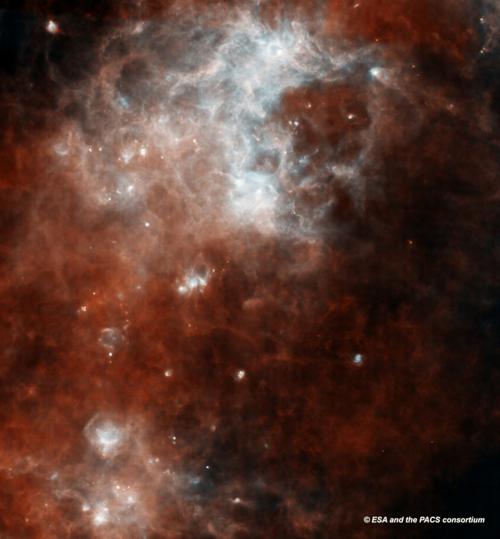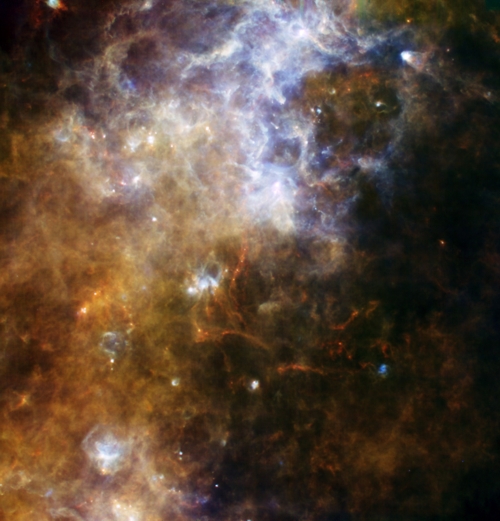| Basic Information | |
| What is this? | A portion of the Galactic Plane |
| Where is it in the sky? | In the constellation of Crux, the Southern Cross |
| How big is it? | The image is about 2 degrees across |
| How far away is it? | Looking through the plane of the Galaxy, up to several thousand light years away |
| What do the colours represent? | Cooler material (observed mostly by SPIRE 250, 350 and 500 microns) appears red, while warmer material (seen by PACS at 70 and 160 microns) is shown in green and blue. |
Downloads
See this object in:
This region of sky is fairly dark when seen in visible light, despite the fact that it is in the direction of the Galactic Plane, where there should be a high density of stars. This is because many stars are hidden behind clouds of dust. When seen in far infrared light, as shown above, the region is far from dark. The cool gas and dust shines at these long wavelengths. In the image above, the cooler material detected by the longer wavelength SPIRE instrument is shown in red, while the warmer material seen by the shorter wavelength PACS instrument is shown in green and red.
The cold material can be as cool as 10 degrees above absolute zero (-263oC), while the warmer material is still no warmer than around -200oC. The larger bright blue-white regions are clouds of gas and dust which are being heated by young, hot stars within, while the darker red regions are more diffuse dust. The small red regions, which look like chains of fairy lights in places, are where the dust are collapsing under gravity. Eventually, each red “fairy light” will probably form a star like our own Sun, while the small blue regions will form much larger, hotter stars.
The image was obtained in the “Parallel Mode” of operation the SPIRE and PACS instruments, which involves both being used simultaneously. This uses the liquid Helium coolant, which is constantly boiling off into space, as efficiently as possible, and allows the two instruments to observe large areas of sky over a large range of wavelengths. This mode uses all three of SPIRE’s channels and two PACS channels, giving five channels simultaneously.
The separate images from the two instruments are shown below. In the SPIRE image (on the left) the 250, 350 and 500 micron channels are shown in red, green and blue respectively. As in the main image, warmer material is blue and cooler material red, but because the SPIRE instrument looks at longer wavelengths the cooldest material from the main image is more dominant. This makes the chains of “fairy lights” more apparent. In the main image, all the SPIRE light is combined and shown in red. The PACS image (on the right) shows the 70 micron channel in red and the 160 micron in blue. These shorter wavelengths show the warmer material, so the “fairy lights” are hidden, while the much warmer dust being heated by the hidden stars is very dominant.

SPIRE 
PACS
Detailed Information
Gould Belt Survey

